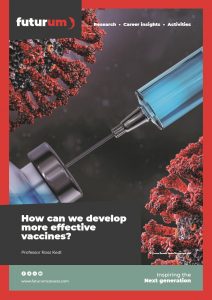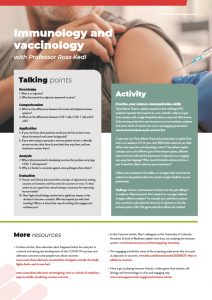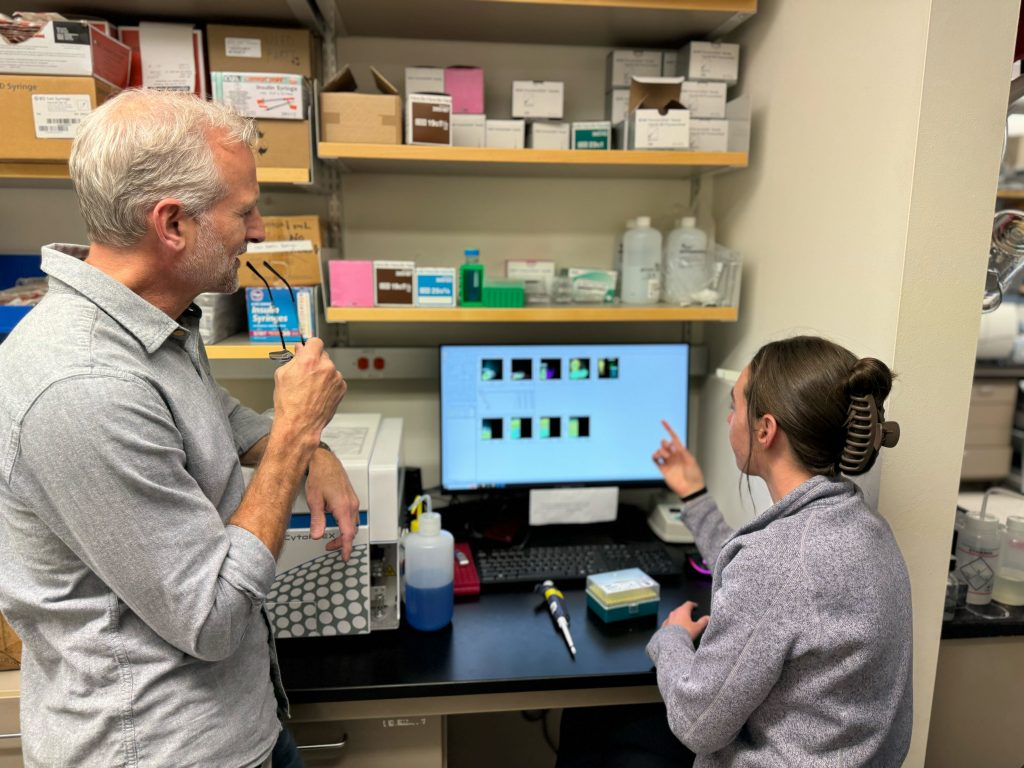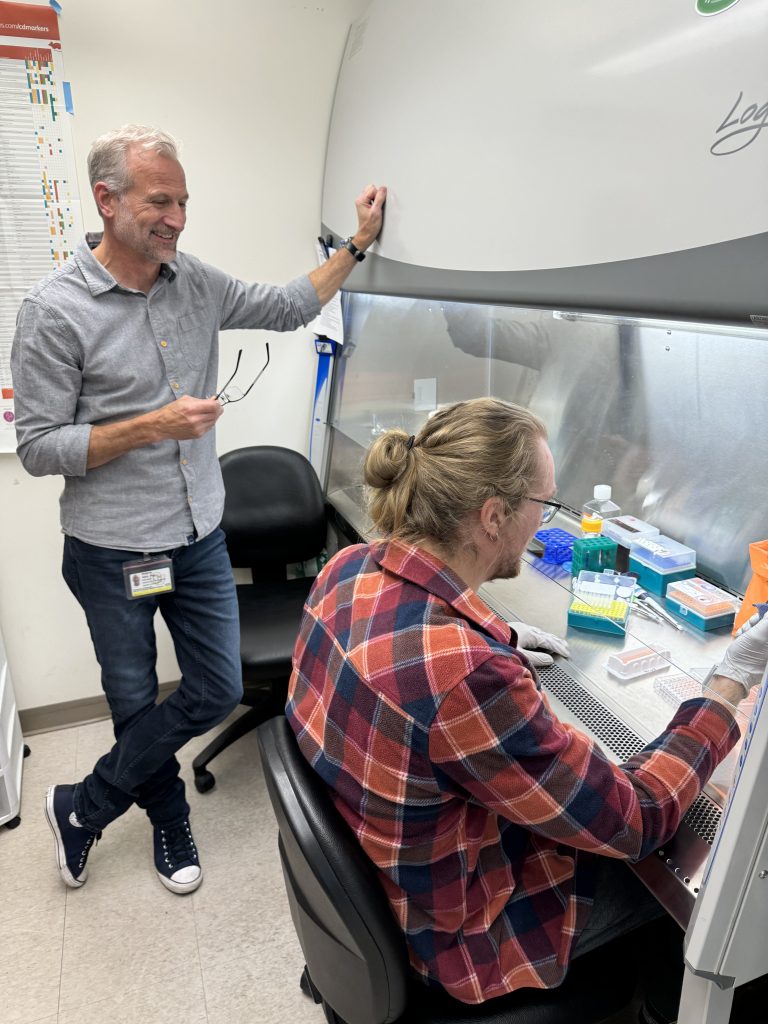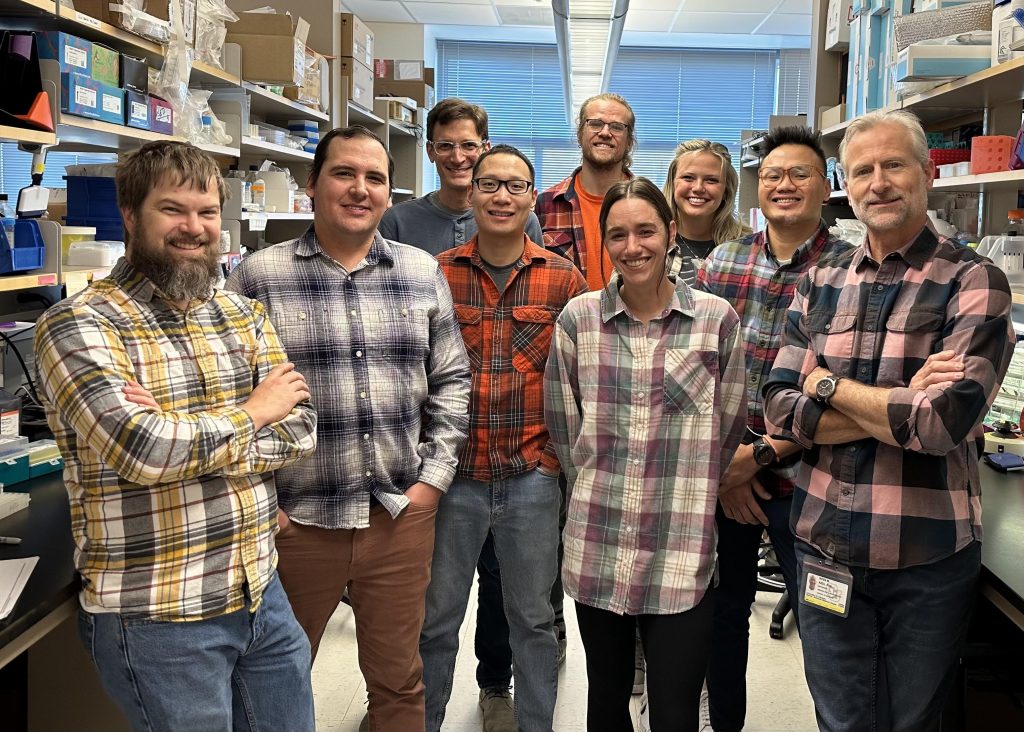How can we develop more effective vaccines?
When the COVID-19 pandemic struck the world in 2020, our everyday lives were put on hold until immunologists and vaccinologists discovered how to protect us. Incredibly, multiple vaccines for the disease were developed and approved for use within record-breaking time. At the University of Colorado Anschutz School of Medicine in the US, Professor Ross Kedl and his team are studying the immune system in the hope of exploiting it to develop more effective vaccines.
Talk like an immunologist and vaccinologist
Adaptive immune system — the part of the immune system that provides a targeted response to specific pathogens
Antigen — a foreign substance (e.g., a pathogen) that triggers an immune response
Adjuvant — a substance added to a vaccine to improve its effectiveness
Antibody — a protein produced by B cells of the adaptive immune system to neutralise pathogens
B cell — an immune cell that produces antibodies
Extracellular — taking place outside a cell
Innate immune system — the part of the immune system that provides a general response to any pathogens
Intracellular — taking place within a cell
Pathogen — a microorganism that can cause disease, such as a virus, bacterium or fungus
Pathogen recognition receptor (PRR) — a protein expressed by an immune cell that identifies pathogens
T cell — an immune cell that destroys infected cells
Your immune system is a complex network of cells and biological systems that protects you from diseases. It is made up of two parts, the innate and adaptive immune systems, which work together to combat infections. “As an analogy, you can think of these two parts of the immune system as a combination of the transportation security administration (TSA) at the airport and more advanced security units,” says Professor Ross Kedl, an immunologist and vaccinologist at the University of Colorado Anschutz School of Medicine. “The TSA officers are very good at detecting possible threats from people or baggage. If a threat is detected, the TSA officers initiate containment efforts, such as closing the airport or grounding planes, then they pass along the information to the police or military, who can devise a specific plan of attack for the threat at hand.” Like the TSA officers, our innate immune system alerts the body to threats from pathogens, before passing control over to the adaptive immune system, which provides a more specialised and targeted response.
How does the immune system respond to pathogens?
Firstly, the innate immune system uses pathogen recognition receptors (PRRs) to identify whether the pathogen is a virus, bacterium or fungus. “At a certain level, any one virus can ‘look’ much like any other virus, and the same is true of bacteria and fungi,” says Ross. “However, an extracellular fungus infection is very different from an intracellular virus infection, so the immune system needs to mobilise different immune cells for different types of pathogens.”
Once the PRRs have identified the type of infection, the innate immune system passes this information to the adaptive immune system. “Armed with this knowledge, the adaptive immune system will set about making a large number of cells and molecules that recognise that type of infection and eliminate it from the body,” Ross explains.
The adaptive immune system is composed of B cells and T cells, which have different methods for protecting our bodies. When triggered by an antigen, B cells produce antibodies, which are soluble protein molecules that travel through the bloodstream and bodily tissues, before binding to the pathogen to help neutralise it. In contrast, T cells destroy infected cells in the body. “There are two main types of T cells – those that coordinate responses to both intracellular and extracellular infections (CD4 T cells) and those that are focused on ‘hand-to-hand combat’ with infected cells (CD8+ T cells),” says Ross. CD8+ T cells can directly kill virus-infected cells and cancerous cells, while CD4 T cells are ‘helper’ cells that activate other immune cells to fight the infection. This is an important distinction, as our bodies need to make sure they produce the right type of T cells to get rid of infections.
For example, if a person is infected with a virus, which replicates inside cells, their immune system needs to produce CD8+ T cells that combat infected cells. However, fungal infections replicate outside of cells in bodily tissues. “In this case, generating CD8+ T cells doesn’t make much sense and would be a waste of energy,” explains Ross. This is because CD8+ T cells only fight infected cells, not infected tissues. Instead, the body would need CD4 T cells to fight a fungal infection.
How do vaccines take advantage of the immune system?
Reference
https://doi.org/10.33424/FUTURUM443
Armed with this knowledge about the immune system, vaccinologists take advantage of the characteristics of our innate and adaptive immune systems to develop vaccines that protect us from pathogens. “T and B cells can live for decades in the body,” says Ross. This means that if you are reinfected by a pathogen you have previously been exposed to, your adaptive immune system will remember how to attack that specific pathogen, allowing your body to produce a targeted and rapid response. It is this feature of adaptive response that allows vaccines to protect us, as they deliver a dead or weakened pathogen, or even just specific molecules derived from the pathogen, into the body so the immune system learns how to fight the infection.
How do adjuvants improve vaccines?
In the 1920s, French veterinarian Gaston Ramon and English immunologist Alexander Glenny were each experimenting and trying to develop a vaccine against diphtheria, a bacterial infection. By injecting hamsters with inactivated diphtheria toxin, the scientists observed that the animals did not produce a strong antibody response to the infection. However, if they first mixed the toxin with another substance before injecting it, the hamsters had a significantly better antibody response.
Any substance added to a vaccine to increase its effectiveness is known as an adjuvant, derived from the Latin word juvare that means ‘to help’. “Adjuvants encourage the immune system to deliver a more powerful response to an infection,” explains Ross. “They stimulate the innate immune system which then causes the T and B cells of the adaptive immune system ‘wake up and pay attention’.”
In Ramon’s case, he discovered that the hamsters’ immune systems responded more to the diphtheria toxin if it was mixed with a range of substances, including tapioca (a starch from the cassava plant), agar (a gel-like substance from algae) and even breadcrumbs! Glenny used alum (aluminium salts) as the adjuvant in his diphtheria vaccine, a substance still used as the adjuvant in many vaccines today.
Why is Ross studying adjuvants?
“Currently, we have vaccines that are very good at making antibodies, which protect us from infectious diseases like COVID-19 and measles,” says Ross. “But if you want your immune system to fight off something you already have, like a chronic disease or cancer, you need to make a lot of T cells for that to work. I’m interested in how to get vaccines to make very large CD8+ T cell responses, to kill virus-infected or cancerous cells.”
Some recent cancer therapies use this technique to encourage the patient’s T cells to kill the cancerous cells. “When this works, it’s remarkable, but it doesn’t work as well or as often as we wish, and one of the reasons is that not everyone makes as many T cells as they need to.” Interestingly, Ross and his team discovered that part of the reason why vaccines do not produce a strong CD8+ T cell response is that the adjuvant is often not effective enough. In response, they are now exploring the effects of combination adjuvants that target multiple molecules of the innate immune system. Having tested their vaccines on mice, these combination adjuvants seem to create a powerful connection between the innate and adaptive immune responses, leading to a much stronger T cell response. After further testing, Ross hopes that the team’s combination adjuvants will be approved for clinical use in humans, paving the way for new vaccines to treat cancer.
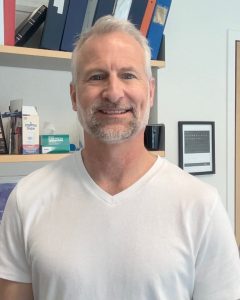 Professor Ross Kedl
Professor Ross Kedl
Department of Immunology and Microbiology, University of Colorado Anschutz School of Medicine, USA
Fields of research: Immunology, vaccinology
Research project: Understanding the innate and adaptive immune systems to develop adjuvants for vaccines
Funder: US National Institutes of Health (NIH)
About immunology and vaccinology
Immunology and vaccinology are closely related fields, but there are key differences between them. While both are branches of medicine and biology, immunology is the study of immune systems, while vaccinology applies this knowledge to develop vaccines that protect against infectious diseases and cancer. There is, therefore, a lot of overlap between immunology and vaccinology, as vaccines work by leveraging the natural ability of our immune systems to form a very specific response against an antigen and then remembering that response for years afterward.
The importance of vaccines
The crucial work of immunologists and vaccinologists was highlighted during the COVID-19 pandemic. As the disease spread rapidly around the world, forcing friends and family members to remain isolated from each other and leaving a trail of devastation in its wake, immunologists and vaccinologists worked overtime for months on end to develop a vaccine against the virus.
Usually, it takes 10-15 years to develop a new vaccine, but, thanks to the urgent need from the global community and the dedication of immunologists and vaccinologists, COVID-19 vaccines were developed in record time. “It’s worth noting that mRNA vaccines were in development for more than 10 years before COVID-19 began and had already been clinically tested for viral diseases such as Ebola and Zika,” says Ross, highlighting how COVID-19 vaccines were developed by building upon previous vaccinology advances. The first COVID-19 vaccines were approved for use less than a year after the disease was first identified, and this huge achievement saved hundreds of thousands of lives, allowed lockdowns to lift and dramatically changed the course of the pandemic.
If a COVID-19 vaccine could be developed so quickly, why have vaccinologists still not developed vaccines for other viruses?
The human immunodeficiency virus (HIV), which causes acquired immunodeficiency syndrome (AIDS), was first identified in the 1980s and has since caused over 40 million deaths around the world, but no successful HIV vaccine has yet been developed. “The virus that causes COVID-19, a beta coronavirus called SARS-CoV2, is a very basic virus that does not have many mechanisms to hide from, or counteract, the immune response against it,” explains Ross. “In contrast, HIV is a much more complex infection. HIV mutates quickly and keeps changing what its surface looks like. This makes it very hard for antibodies to bind to and neutralise the virus. On top of that, HIV infects CD4 T cells, which are needed to not only fight the virus but to maintain a healthy immune system to fight off any other diseases, so developing a vaccine against HIV is much more complicated.”
Pathway from school to immunology and vaccinology
• At school and post-16 years, study biology and chemistry to learn about the human body, cells and biochemical processes. It would also be useful to study English, as communicating research results and writing grant applications are an important part of scientific jobs.
• At university, a degree in biology, immunology, biochemistry or biomedical science could lead to a career in immunology or vaccinology. “Take classes in genetics, microbiology and immunology if they are offered,” says Ross.
• Try to get some hands-on experience in a research lab while you are studying. Look for summer internships and ask faculty members in local immunology or vaccinology departments if they have any research or job shadowing opportunities. “You’d be surprised at how open professors are to taking in interested students, no matter their age,” says Ross.
• The University of Colorado Anschutz School of Medicine offers a number of outreach opportunities for schools in the local area, as well as summer lab research experiences for high school and undergraduate students: www.cuanschutz.edu/offices/inclusion-and-outreach/programs
Explore careers in immunology and vaccinology
• There is a wide variety of career paths in immunology and vaccinology, including working in academia, medical settings or in the pharmaceutical industry. “The immune system is involved in all organs and biological processes, so studying immunology opens up the entire world of research in medical biology,” says Ross.
• The University of Colorado Anschutz School of Medicine has many online resources for students, including informative videos, that explore ideas in immunology and vaccinology: medschool.cuanschutz.edu/immunology-and-microbiology/teaching-resources/curriculum-resources/curriculum-resources-videos
• The American Association of Immunologists (www.aai.org/Education) and the British Society for Immunology (www.immunology.org/careers) both have a wealth of resources about studying and working in immunology.
Meet Ross
I was captured by biology thanks to my high school biology teacher, Mr Strand. He was an all-round great teacher, but when he talked about how the DNA in my cells carried all the information necessary to make another ‘me’, I was hooked.
My plan was to teach high school biology. After graduating with an undergraduate degree in biology from the University of Minnesota, I enrolled in their post baccalaureate secondary education programme. I was accepted, but I deferred my place for a year while my wife finished her degree. During that time, I worked in a research lab on campus. About six months in, I was performing an experiment called a ‘Western blot’. I didn’t have time to complete the experiment because it was late in the day and we had company coming over for dinner, so I put the incomplete blot in the lab fridge for the night. I don’t remember anything about dinner that night because I was so distracted by how my experiment might have gone. I eventually got up at 4am and went to the lab to find the answer. As it turns out, the experiment was a total flop! But I was already troubleshooting and problem solving what might have gone wrong, what I could do next and how I could make the experiment successful. It suddenly occurred to me that if this sort of thing was keeping me up at night, I should probably rethink my career path and consider doing research.
My first job as an independent researcher was at 3M Pharmaceuticals. The company had developed many novel compounds which I thought could be interesting as vaccine adjuvants. It was my time at 3M that sparked my initial and ongoing interest in using adjuvants to make better T cell responses. We made some interesting discoveries while I was there, including discoveries about combination adjuvants, however 3M had no interest in pursuing these ideas commercially. So, I formed a small start-up company called ImmuRx with some colleagues to explore combination adjuvants further. While we never got to see our work in clinical use, my experience at 3M and ImmuRx gave me the expertise to consult with companies attempting to commercialise products targeting anything from immune regulation to gene therapy.
Most people don’t know this, but being a tenured faculty member only means that the university agrees to pay half my salary. They provide nothing for my actual research, or to pay for my lab members to do the research, so I have to write grants to get funding to cover the expenses of lab supplies and salaries. Though the grant writing is heavy work at times, it’s worth it for the fun of the research I get to do.
Trying to unravel the mysteries of the immune system has always held my fascination like nothing else in science. I also enjoy training students and early career researchers and seeing their passion and excitement for the work come alive and flare into a lifelong pursuit.
Ross’ top tips
1. Get to know people. Science is best done in a community, and the people you meet today are going to be your employers, grant readers and manuscript editors tomorrow.
2. Be humble. If you aren’t, there’s a good chance you will eventually be humiliated.
3. Passivity is not an asset. Actively engage in your future!
4. Stay curious.
Do you have a question for Ross?
Write it in the comments box below and Ross will get back to you. (Remember, researchers are very busy people, so you may have to wait a few days.)

